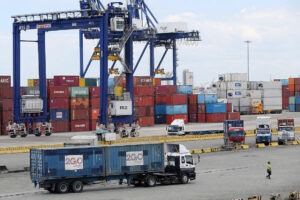By Isa Jane D. Acabal
THE PHILIPPINES’ trade deficit in goods narrowed in September, as exports posted double-digit growth, the Philippine Statistics Authority (PSA) reported on Thursday.
Preliminary data from the PSA showed the country’s trade-in-goods balance — the difference between exports and imports — stood at a deficit of $4.35 billion in September, 14.7% smaller than the $5.1-billion deficit a year earlier.
Month on month, the trade gap widened to a two-month high from the revised $3.99 billion in August.
The latest figure was the widest trade deficit since the $4.42-billion gap in July 2025.
In the January-to-September period, the trade deficit narrowed to $37.18 billion, down 5.7% from the $39.43-billion gap in the same period last year.
The country’s trade balance has been in deficit for over a decade or since the $64.95-million surplus recorded in May 2015.
Total outbound sales of Philippine-made goods climbed by 15.9% year on year in September to $7.25 billion, faster than the 5.5% increase in August and a reversal from the 7.6% drop in September 2024.
It was the quickest pace for exports in two months or since the 17.6% growth in July.
Year to date, exports increased by 13.1% to $63.02 billion.
On the other hand, merchandise imports jumped by 2.1% year on year in September, a turnaround from the revised 0.3% drop in August but slower than the 10.1% expansion a year ago.
The import bill in September reached $11.6 billion — the biggest in two months since $11.77 billion in July.
In the first nine months, imports rose by 5.3% to $100.19 billion.
The Development Budget Coordination Committee projects a 2% contraction in exports and 3.5% growth in imports this year.
“The trade deficit slimmed on a yearly basis as exports growth outpaced imports growth. Exports (were) likely buoyed as foreign businesses stocked up ahead of the (fourth-quarter) holiday rush and with more certainty regarding the US tariff situation,” Marco Antonio C. Agonia, an economist from the University of Asia and the Pacific, said in an e-mail.
The US began imposing a 19% tariff on many goods from the Philippines on Aug. 7.
“The imposition of reciprocal tariffs [by the United States] may have initially slowed exports growth in August but likely allowed supply chains to adjust with some degree of certainty in September,” Mr. Agonia said.
The peso’s weakness against the US dollar in September may have also allowed Philippine exports to be more competitive in the global market, he added.
In September, the peso averaged P57.2501 against the dollar, a tad stronger than the P57.2525 average in August, according to the latest central bank data. On an annual basis, the peso depreciated by 2.06% against the US currency, worse than the 0.1% drop in August.
By major type of goods, manufactured goods made up the largest portion of total export receipts, rising by 15.9% year on year to $5.74 billion in September.
Exports of mineral products also rose by 8.9% to $703.68 million in September, while petroleum products declined by 17% to $22.05 million.
Electronic products continued to be the country’s top export commodity, climbing by 27.9% to $4.02 billion and accounting for more than half of total exports.
Semiconductors, a subset of electronic products, jumped by 32% to $3.05 billion in September. Semiconductor exports are currently exempted from the 19% US tariff.
“Philippine exports remained resilient in September, as modest growth in US-bound goods were outpaced by stronger gains in other markets,” Chinabank Research said in a research note.
The United States was the main destination of Philippine-made goods in September, accounting for 15.3% or $1.11 billion of total export sales. This was followed by Hong Kong, which accounted for a 15.1% share or $1.1 billion, China with a 13.2% share or $959.19 million, Japan with a 12.2% share or $883.33 million and the Netherlands with a 4.5% share or $325.78 million.
“Exports remain supported by electronics shipments, possibly to areas outside the USA. So far it seems as though Philippines has been able to find alternative export destinations so far,” Nicholas Antonio T. Mapa, chief economist at the Metropolitan Bank & Trust Co., said.
REBOUND IN IMPORTSMeanwhile, the slow imports growth in September reflects the impact of the peso depreciation.
“Importers may have downsized purchases as the price of imported goods mounted with the peso weakness,” Mr. Agonia said, adding that bad weather may have also contributed to the lackluster growth in imports.
Raw materials and intermediate goods, which made up the bulk of the country’s total imports in September, fell by 4.9% to $4.13 billion.
Imports of capital goods rose by 23.8% to $3.77 billion in September, while consumer goods fell by 7.1% to $2.38 billion.
On the other hand, imports of mineral fuels, lubricants and related materials declined by 6.2% to $1.28 billion.
“Imports on the other hand saw lower inbound shipments save for capital goods which was a welcome development to help boost productivity in the medium term. Recent rate cuts by the (Bangko Sentral ng Pilipinas) may finally be starting to help support capital spending of corporates,” Mr. Mapa said.
China remained the top source of imports, accounting for 28.4% or $3.29 billion of the total import bill in September.
It was followed by South Korea with a 9.1% share or $1.06 billion, Japan with 8.1% or $935.07 million, Indonesia with 7.1% or $821.42 million and the US with 6.3% or $728.88 million.
UNCERTAIN OUTLOOKGeorge T. Barcelon, chairman of the Philippine Chamber of Commerce and Industry, said in a Viber message that more imports are now coming in as companies get ready for the holiday season.
Mr. Mapa said the outlook for trade is still uncertain, “given ever changing tariff schedules, but capital formation recovery should continue.”
For Mr. Agonia, exports growth may remain healthy in the last quarter of the year, as the peso depreciation boosts the competitiveness of exports.
“However, imports will likely jump as the holiday season commences, and the National Government catches up on its spending plans. We could encounter larger trade deficits as a result,” he said.
Chinabank Research expects the narrower trade deficit in September to have a positive impact on overall gross domestic product (GDP) growth in the third quarter.
The PSA will release the third-quarter GDP on Nov. 7.


















